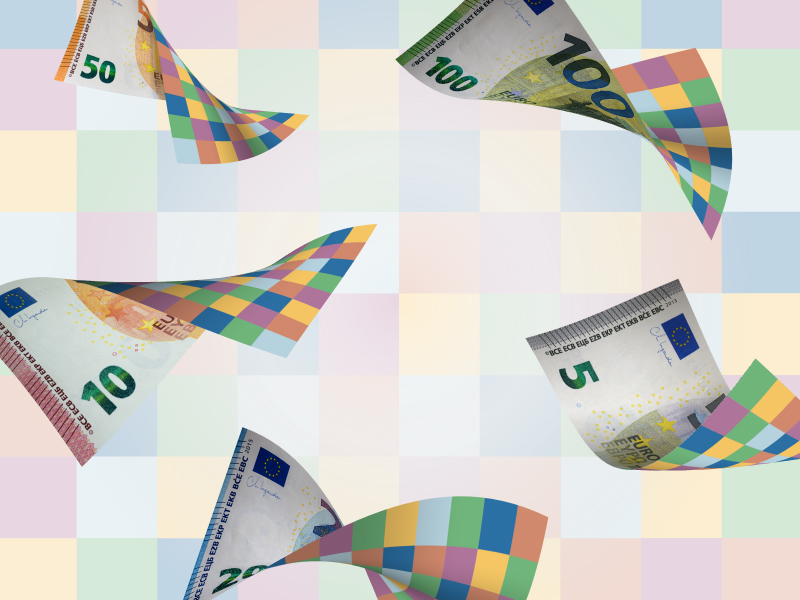- THE ECB BLOG
What makes a good banknote?
24 August 2023
Our money needs to be easy to handle, appealing and difficult to counterfeit. This ECB Blog post talks you through good banknote design – and seeks your advice.
Banknotes can be iconic and tell unique stories. They can feature mythical creatures, local heroes, national treasures, or natural wonders. Museums showcase specimens of banknotes from across the globe, highlighting their historical context and the creativity of their design. And we use them almost every day to buy our groceries, pay for a newspaper or tip at a restaurant. But have you ever thought about what it takes to develop a good banknote? Or why they have that particular size or look? This blog post provides some answers by exploring the design principles for state-of-the art banknotes.
Check your cash in the blink of an eye
One of the most important features of money is that people need to trust it. To ensure this confidence, we need to be sure that the paper in our hand is actually a genuine banknote, and not a counterfeit. But most people in the euro area usually do not spend a lot of time checking euro banknotes. So, how do we make sure that everyone can authenticate and trust banknotes, despite paying little attention to them? Well, we need security features that are clearly visible, difficult to counterfeit and easy to check in the blink of an eye. These features include holograms, watermarks, colour-shifting inks and security thread. Take a look at the image of Princess Europa in the portrait window of the €20 banknote by holding it up to the light, for example. What security features can you find by feeling, looking at and tilting a euro banknote?
The ECB is constantly investigating new technologies in cooperation with national central banks, research institutions and the private sector. We look for novel security features for future banknotes. Tools from neuroscience can, for example, assess how a person reacts in the first milliseconds after seeing and touching a banknote, before even consciously thinking about it. Such tests help us see how particular banknote features are observed, learned and memorised. As technology develops, however, counterfeiters are unfortunately also able to produce ever more sophisticated counterfeits. The key for us is to always be a step ahead – and that means continuous investment into cutting-edge research and development.

Banknote size matters
It may be easier and cheaper to produce and store banknotes when all denominations have the same dimensions. But that would make it more difficult for people to distinguish one denomination banknote from another. As automation increases, banknotes must also be easy for cash dispensers and vending machines to handle. Practical considerations about how banknotes are handled by people, like the dimension of their wallets, and by the cash industry and retailers are therefore all important in determining the ideal size for a banknote. Banknote size is also not something that can be changed on a whim, as a lot of modification and investment would be required to adapt vending and cash machines, cash tills and storage containers.
And a banknote’s design should work for everyone. The ECB consults relevant groups, like the European Blind Union, to get their insights on the performance as well as the impact of the size of the banknotes. Visually impaired and blind people need to be able to check that a banknote is genuine just by touching and feeling it. Accessibility features like different sizes, tactile marks and high contrast colours are therefore needed. Euro banknotes, for example, have specific raised lines on the edges of their front side so that the correct denomination can be easily identified.
Money made to last
Euro banknotes are used multiple times once they are issued and circulate, and at present there are around 29.6 billion of them in circulation. It’s important to keep these banknotes in good shape for as long as possible. Have you ever accidentally ironed a banknote or washed one in a washing machine? While security features don’t disappear, they can only be effective if banknotes are not worn out and remain free of damage. Banknotes therefore have to be resistant to tearing, fading and discolouration, and worn or damaged banknotes need to be taken out of circulation as soon as possible.
The average lifespan of a banknote depends primarily on the denomination and whether it is frequently used for payments or stored for later use. Lower denominations are handled more frequently than higher ones, and on average last for four years. Higher denominations, which are more likely to be used as savings, can circulate for ten years or more.[3] We are investigating how to make banknotes more durable and further extend their lifespans without compromising security.
The materials used to produce banknotes are an important factor in their durability. Euro banknotes, like most currencies, are made of cotton. As part of our commitment to reducing the environmental impact of euro banknotes, we only use cotton produced as a by-product of yarn production. In fact, by the end of 2023 all new euro banknotes will be produced with 100% sustainable cotton.
Banknotes tell stories
In addition to these rather technical aspects of cash design, banknotes also have a cultural function. For many countries, especially when they are newly founded, the face of their own new national currency is an important expression of national identity, just like the euro is a tangible symbol of Europe. Banknotes tell a story and can be emotionally charged. People may, for instance, feel a connection to the persons, places or objects depicted on their banknotes.
German Mark banknotes, for instance, had historical figures such as composer Clara Schumann and mathematician Carl Gauss on them. Dutch guilder banknotes used to adopt a more abstract and symbolic design, e.g. a lighthouse to refer to the coast and sunflowers to represent painter Vincent van Gogh. And French franc notes used historical motifs, such as Delacroix’s famous painting recalling the French revolution on the 100 franc banknote. Outside of Europe, the South African rand depicts the animals of the “Big Five” (lion, rhino, elephant, buffalo and leopard). A more recent series features the same animals with their babies. This demonstrates how banknote visuals can develop over time and even tell stories of birth and life.[4]
It can be challenging to tell a story that is relatable to 346 million Europeans from 20 countries, with diverse languages, backgrounds, and aspirations. So, what is our banknote story? Current euro banknotes feature architectural styles from various periods in Europe’s history. Windows and doorways on the front sides symbolise the European spirit of openness and cooperation. The bridges on the reverse side represent communication between the people of Europe and between Europe and the rest of the world. While the bridges were all just stylised examples when the banknotes were issued in 2002, the Dutch town of Spijkenisse has since built full-scale replicas.
What are your preferences?
We need to make sure that euro banknotes are regularly updated to remain secure in the face of rapidly evolving counterfeiting technologies and to reduce their environmental footprint. Our banknotes are also supposed to mean something to Europeans, to remind them of ideas and values that matter to all. For the first time, we are now looking into changing the theme and visuals on euro banknotes. And this is where you come in. What do you think these should be? Animals, historical figures, art, or something quite different? We are conducting a survey and want to invite you to take part. Which of the seven shortlisted themes do you prefer, and why? The findings will inform the decision-making process for the theme for future euro banknotes.
The views expressed in each blog entry are those of the author(s) and do not necessarily represent the views of the European Central Bank and the Eurosystem.
Subscribe to the ECB blogElisabeth Schulz is a Principal Counterfeit Expert in the ECB's Currency Development Division.
Jozef Vrana is a Principal Banknote Issuance Expert in the ECB’s Currency Management Division.
For more information on banknotes see the Deutsche Bundesbank's explainers.
Media release on upgraded banknotes and coin, South African Reserve Bank





